These specimens were cleaned and conserved as part of University College London Grant Museum of Zoology’s
Bone Idols Project (funded by NatSCA, Arts Council
England's Museum Development Fund and various members of the public).
1. Juvenile orang-utan (Pongo sp)
This skeleton and its wooden base were quite dirty. Both required dry cleaning (soft brush and hoover with gauze over the nozzle) followed by wet cleaning with Synperonic-A7 and de-ionised water using cotton bud swabs, followed by cleaning with cotton bud swabs dipped in distilled water. The bones were kept as dry as possible by cleaning small areas at a time and frequently patting the area dry with small lint-free paper towels.
Additional supports (thin metal rods) were required underneath the body and underneath the right wrist to reduce the stresses on the skeleton, especially when it is being moved. These rods are bent into shape at the top to hold the specimen and provide support, and are inserted into holes drilled in to the plinth, after a dab of Paraloid B72 glue was applied. At the top of these rods, the rods and the bones were tied together with thin polypropylene thread, to ensure they stayed in place when the specimen is being moved. Bottle tops were removed from the underside of the plinth and wooden batons were glued to the underside instead. Small holes in the plinth were filed with Milliput epoxy putty and the whole plinth was painted black with artists’ acrylic paints. The upright branch was held in place on the plinth with wire and the branch was loose and prone to swivelling round and causing damage to the left hand (the thumb was detached). Therefore Milliput epoxy putty was applied to the gap between the underside of this branch and the plinth, to hold it more firmly in place. This putty was painted with artists’ acrylic paints to match the branch. As the left hand was loose and not attached to the branch and was prone to bouncing when the specimen was moved, this was secured to the branch by tying one of the digits with thin polypropylene thread to a hook inserted into a hole where a thin nail had previously been inserted.
Three digits had been broken off in the past and needed to be adhered back in place: the ‘thumb’ of the left hand (from which one bone is missing) and the second and fifth toes of the left foot. Other digits were realigned as they had curled underneath the feet.
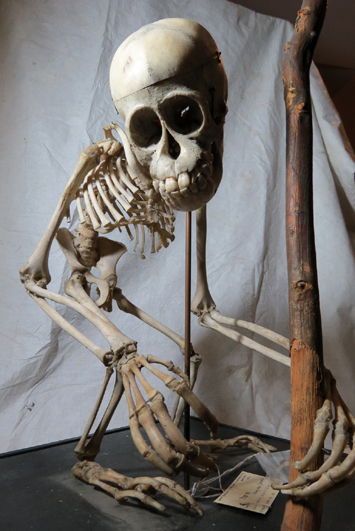
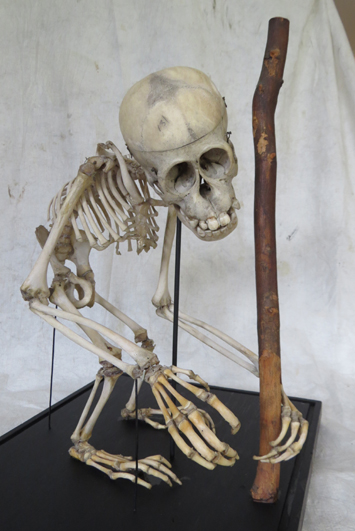
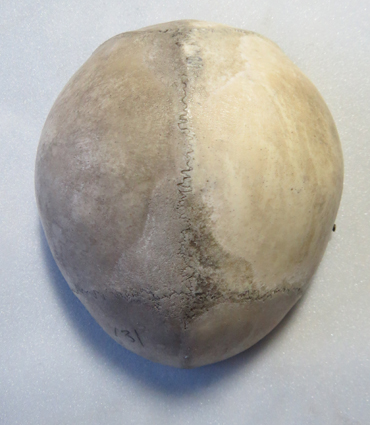
Above left, the Orang-utan specimen before cleaning and conservation. Middle, the same specimen after conservation.
Right, halfway through cleaning the skull.
2. Chimpanzee Pan troglodytes
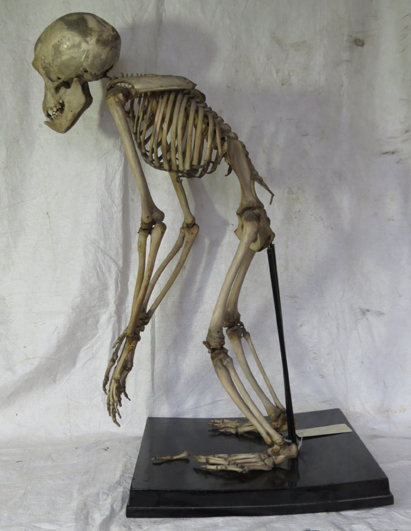
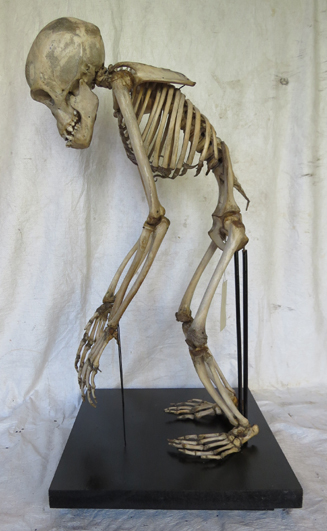 This skeleton was quite dirty and the wooden base was dirty also. Both required dry cleaning (soft brush and hoover with gauze over the nozzle) followed by wet cleaning with Synperonic-A7 and de-ionised water using cotton bud swabs, followed by cleaning with cotton bud swabs dipped in distilled water. The bones were kept as dry as possible by cleaning small areas at a time and frequently patting the area dry with small lint-free paper towels.
This skeleton was quite dirty and the wooden base was dirty also. Both required dry cleaning (soft brush and hoover with gauze over the nozzle) followed by wet cleaning with Synperonic-A7 and de-ionised water using cotton bud swabs, followed by cleaning with cotton bud swabs dipped in distilled water. The bones were kept as dry as possible by cleaning small areas at a time and frequently patting the area dry with small lint-free paper towels.
Because the wooden plinth was quite bowed it meant that the skeleton was leaning forward and the base would rock backwards and forwards. Therefore the plinth was replaced by piece of thick MDF cut to the same size, with Dacrylate applied to reduce VOCs before it was painted black to match the original plinth. The plinth also had wooden batons glued to the underside so that the plinth and specimen can be picked up easily. The rod for the skull was too long, so that the skull did not meet up with the atlas vertebra and would wobble around uncontrollably. Therefore the metal rod was shortened and reshaped to ensure a better and more secure fit. The rear of the skull has now been tied to either side of the atlas vertebra with thin polypropylene thread to reduce how much it wobbles when the specimen is being moved.
Support was needed for the two forearms, to reduce their movement and the consequent stresses on the pectoral girdle and the rest of the skeleton. Therefore a thin vertical rod was inserted under each wrist, bent into an appropriate shape at the top to hold the bones and provide support, and at the bottom they were inserted into holes drilled in to the plinth, after a dab of Paraloid B72 glue was applied. At the top of these rods, thin polypropylene thread was used to ties the bones, to ensure they stayed in place when the specimen is being moved in the future. Two digits (the left thumb and a toe of the right foot) that had fallen off were re-adhered in place with Paraloid B72 adhesive and other digits were realigned as they had curled underneath the feet.
Left, the Chimpanzee specimen before conservation and cleaning.
Right, the same specimen after conservation and cleaning, including replacing the plinth. Below left, the hands of the chimpanzee after the hand on the left had been cleaned. Below right, in some areas excessive amounts of glue had been applied in the past and this had to be removed.

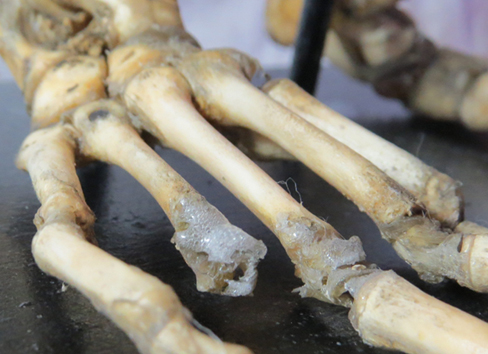
3. Lar gibbon (Hylobates lar), also known as the white-handed gibbon. 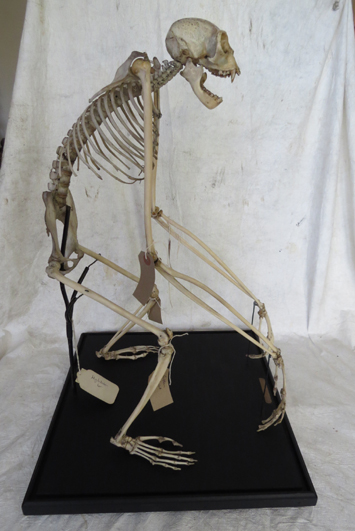 This skeleton was quite dirty and the wooden base was dirty also. Both required dry cleaning (soft brush and hoover with gauze over the nozzle) followed by wet cleaning with Synperonic-A7 and de-ionised water using cotton bud swabs, followed by cleaning with cotton bud swabs dipped in distilled water. The bones were kept as dry as possible by cleaning small areas at a time and frequently patting the bones dry with small lint-free paper towels.
This skeleton was quite dirty and the wooden base was dirty also. Both required dry cleaning (soft brush and hoover with gauze over the nozzle) followed by wet cleaning with Synperonic-A7 and de-ionised water using cotton bud swabs, followed by cleaning with cotton bud swabs dipped in distilled water. The bones were kept as dry as possible by cleaning small areas at a time and frequently patting the bones dry with small lint-free paper towels.
One digit on each foot was misplaced and required adjustment and the cartilage of the lower left rib was hanging rather loose and had to be adhered into place (with Paraloid B72). The forelimbs used to hang over the front edge of the plinth, so the main upright rod supporting the body was moved as far back on the plinth as possible so that the hands remained above the plinth and not overhanging the edge. Extra support was required for the forelimbs and pectoral girdle in the form of placing upright rods securely beneath both wrists. The heads of the femurs needed to be adjusted to sit in the correct anatomical position, and the scapulae needed to be repositioned correctly. The scapulae are now tied on with thin polypropylene thread, and the feet are tied to the nails in the plinth with thin polypropylene thread as well. The right hand was hanging off at the wrist and had to be re-glued into position as did the thumb of the right hand.
Far right, the gibbon skeleton after cleaning and conservation.
Below: Left, one of the feet before cleaning and realignment. Middle, the same foot after cleaning and realignment. Right, , the left hand with the proximal bones cleaned and the distal ones still dirty.
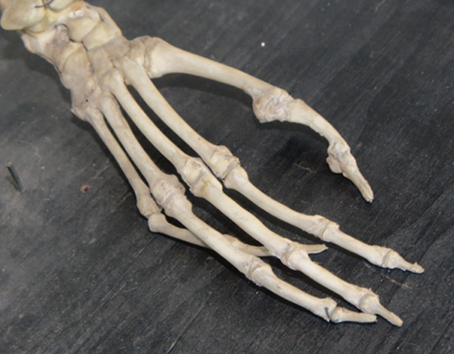
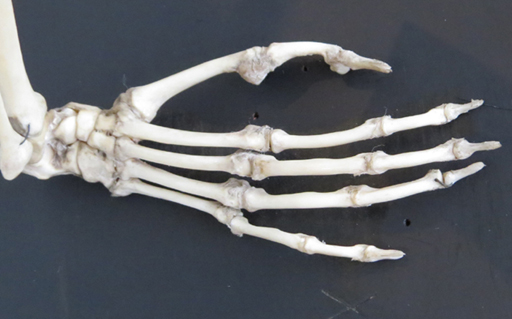
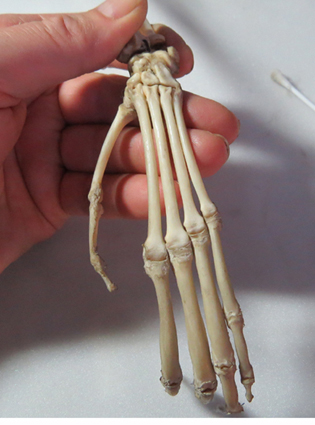
For more details about what we can do for you, or for a quote, please
contact:
enquiries@natural-history-conservation.com
We
are members of ICON, the Institute of Conservation